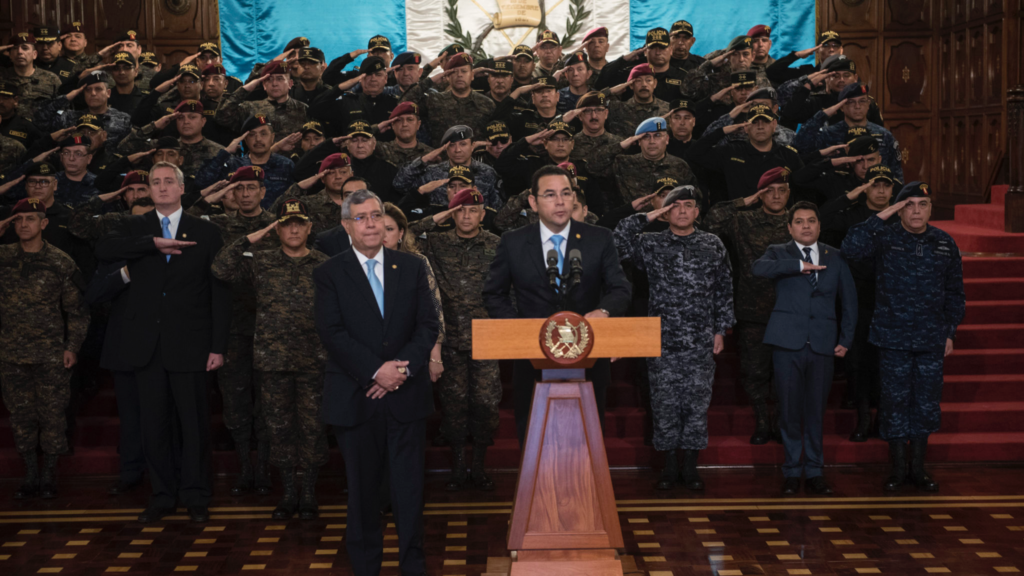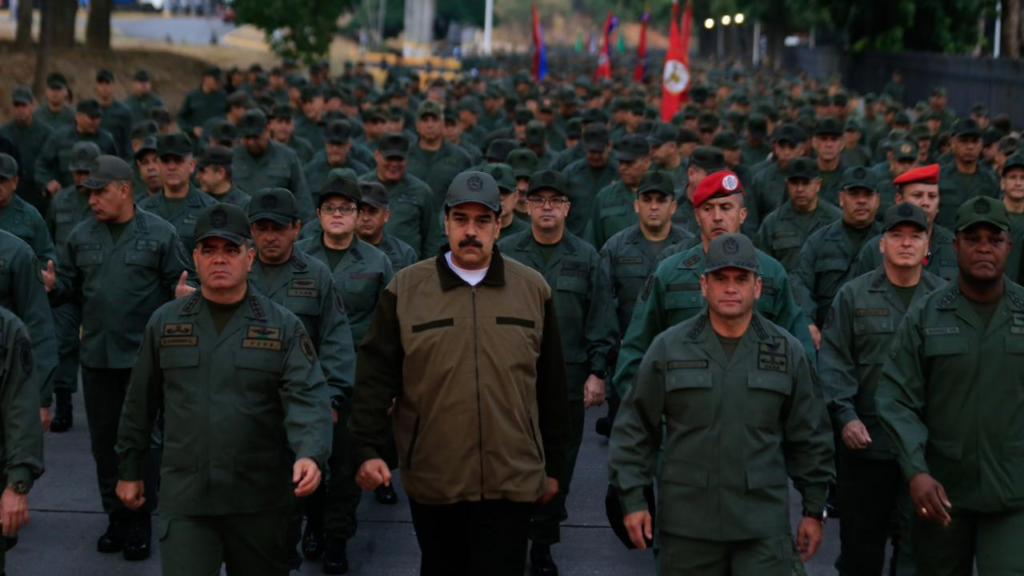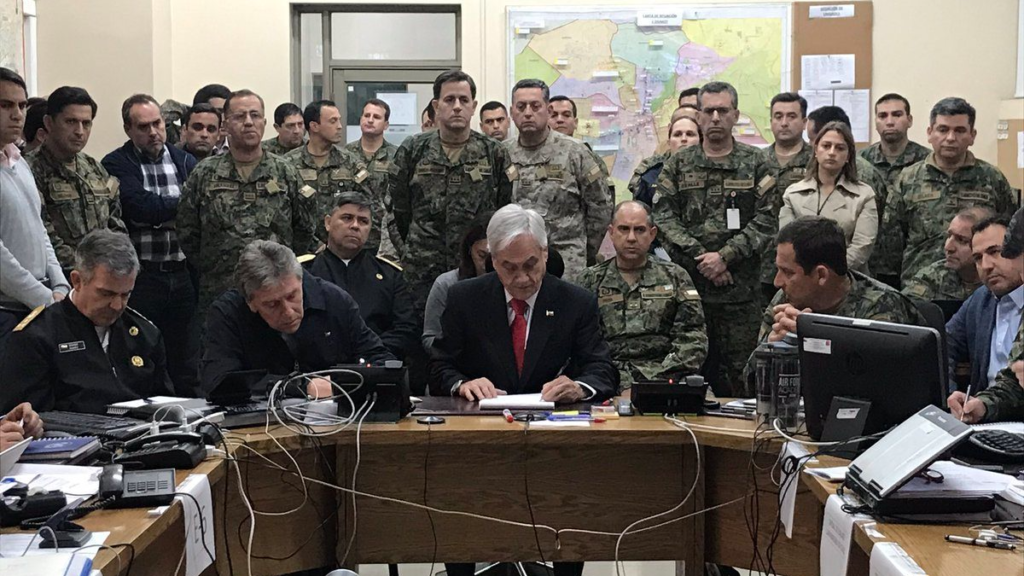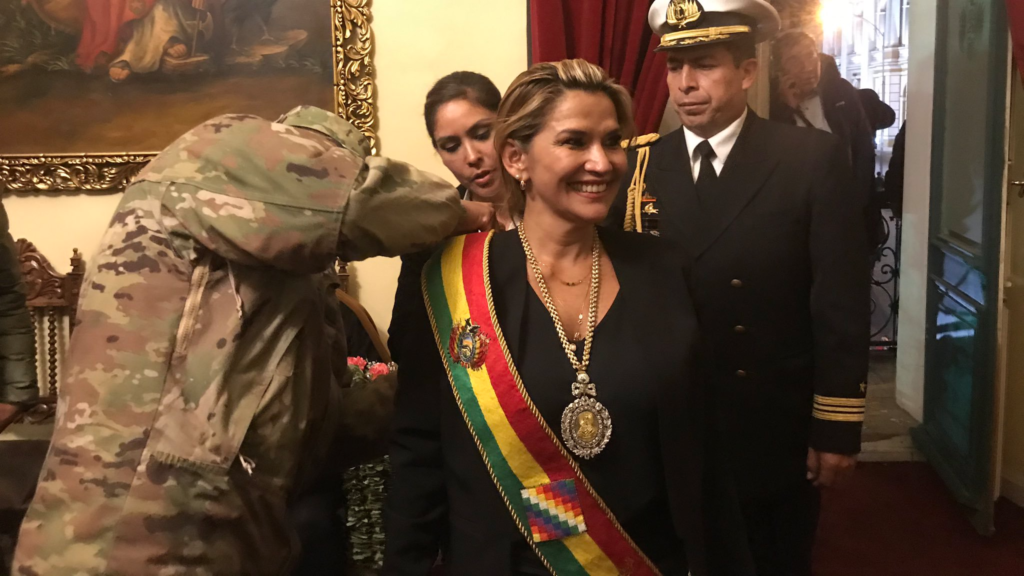(AP Photo/Ricardo Mazalan)
(AP Photo/Ricardo Mazalan)
The past year’s photographic record offers a repeated image in Latin America. A president—usually one with low approval ratings—announces a politically risky or unpopular move, often a crackdown on social protests or dissent. To give the announcement more weight and menace, the president issues it while surrounded by uniformed military officers. The subtext is “the military is with me on this”—even if the message is a political one that doesn’t fall within the military’s responsibilities.
Thus we have Guatemalan President Jimmy Morales, announcing the closure of the International Commission against Impunity in Guatemala (CICIG) in late August 2018:

Honduras’s Juan Orlando Hernández, announcing the “total deployment” of military and police personnel to respond to June 2019 protests:

Venezuela’s Nicolás Maduro, after the opposition’s unsuccessful April 30 uprising:

Peru’s Martín Vizcarra on October 1, responding to the Congress’s attempt to unseat him, days after Vizcarra announced the “constitutional” dissolution of the legislature:

Ecuadorian President Lenin Moreno in early October, announcing that due to protests in Quito he would be governing from Guayaquil while a state of emergency continued:

Chilean President Sebastián Piñera in mid-October announcing, in response to protests, the first state of emergency (other than for natural disasters) since the Pinochet dictatorship. “We are at war,” Piñera declared:

In any democracy, it’s uncomfortable to have the government’s lethal capacity concentrated in one hierarchical, disciplined force—a force that has a very different culture than the civilian government and society. Even where elected civilians have supremacy, civil-military relations are complicated.
They’ve been especially complicated in Latin America. For most of the region’s history, the military propped up civilian dictators or small elites, or staged coups d’état and held power themselves. In power, they fared no better than civilians: they engaged in corruption, mismanaged economies, and committed gross human rights violations.
But then, starting in the 1980s and accelerating after the Cold War ended, there was a hopeful moment in Latin America. The armed forces left presidential palaces amid transitions from dictatorship to democracy. They left non-defense ministries to civilians. Many countries named civilians as defense ministers. Countries that didn’t have them created civilian police forces. Several cut the size and budgets of their armed forces. Some held officers accountable, in civilian courts, for past human rights abuses.
By the late 1990s, analysts had mostly stopped worrying about coups. Countries that had violently changed regimes since independence saw an unprecedented period of democratic stability. Conservative militaries put up, mostly, with elected leftist governments—or in Venezuela were actually subsumed into them. Academic study of civil-military relations in Latin America didn’t grind to a halt, but the pace of new books and studies slowed.
“At the dawn of a new century, civil-military relations in Latin America are more stable than they were a decade or two ago,” David Pion-Berlin wrote in 2001. “In most countries of the region, the military has been diminished in size, resources, influence, and stature. It cannot wield the threat of coup d’état as convincingly as it had in the past, nor is it clear that it would want to.”
Pion-Berlin and others warned, though, that the transition was far from complete. Felipe Aguero and Claudio Fuentes (2009) warned about the military’s continued popularity compared to slow-moving, often corrupt civilian democratic institutions, and what that could mean in a crisis, when “the citizens’ gaze always turns to military institutions.” Latin American militaries kept a lot of prerogatives despite the democratic transition, as Andrei Serbin noted recently. They have their own private-sector investments. There’s still very little scrutiny over their budgets. Human rights violations are still very hard to prosecute. Civilians are rarely more than a rubber stamp over promotions.
And today, the pendulum is swinging back, fast, in the militaries’ direction. It probably won’t go so far back that Latin America re-enters an age of military juntas holding total power. It’s hard, though, to see where or how far it will go.
In addition to the episodes in the photos above, 2019 has seen:

This is all evidence of politicization of the military, and a big expansion of internal roles that had been shrinking between the 1980s and the 2000s. It raises questions not just about how far it might go, but about how real and deep the democratic opening was in the first place. Was it just a brief pause from Latin America’s “normal” of military intervention in civilian affairs? Are we returning to that “normal” now, at a time of high crime, corruption scandals, and sluggish, commodity-dependent economic growth?
Latin America’s turn back to its militaries didn’t just start in the last year. Even at the height of the armed forces’ post-transition return to the barracks, seeds were being planted around the region. A few examples:
And of course, a huge watershed moment was 2009 in Honduras, when political and business elites aligned with the military to remove a sitting president, taking him from the presidential palace in his pajamas and shipping him out of the country. That they got away with it makes Honduras a potential template for the armed forces’ involvement in “soft coups”: sudden changes in government for which the military is instrumental, but after which the officers themselves don’t end up holding power.
We may see variations on the Honduran template play out more often over the next several years in Latin America, with results as disastrous as we’ve seen in Honduras, from where a quarter of a million people—one in every 37 Hondurans—fled and were apprehended at the U.S.-Mexico border in 2019.
But there are other trends that should worry us, even more than coups. Here are five.
That’s why they keep having their pictures taken with them. Political parties and civilian institutions (police, justice systems) poll badly nearly everywhere, with respondents showing much more trust in the armed forces. Even though they have corruption, disciplinary, and factional problems, militaries have clear hierarchies, codes of conduct, a strong internal culture, and a separateness from society even as most people have friends or relatives in the service. The civilians have none of that, and when economies are struggling, they even lack resources. They don’t have what Harold Trinkunas (2000) has called “regime leverage” over the armed forces.
Often, these weak politicians are motivated not by fear of a military coup, but by fear of not being able to recur to the military in a crisis, whether to put down protest or just to lend its prestige and popularity. As a result, weak leaders end up having to cede prerogatives to the military, converging on priorities favorable to the officers in order to keep them by their sides in the camera frame.
Javier Corrales explains in a recent analysis for Americas Quarterly (the emphasis is ours):
Unable to deliver high economic growth, governments are disappointing the middle class. In response, vulnerable and middle-class sectors decide to protest. Some of these protests have resulted in violence. To meet this unrest, governments have decided to rely on the military and intelligence agencies.…[W]e are seeing a new justification for militarization: to deal with organized civil society.
The use of military personnel against social protest, even more than their use against crime, recalls the “national security doctrine” of the Cold War. Organized citizens are viewed as potential threats to stability, and to the state. Leaders view the threat they represent as beyond the government’s normal order-keeping capacities, so they use—or threaten to use—military force. Certainly, some of these protests aren’t entirely peaceful: “The problem is that oftentimes organized civil society in Latin America is not that civil,” Corrales continues. Still, since armed forces are not trained to de-escalate confrontations with citizens, employing them in the response to social protest will bring more human rights violations. It is already doing so.
This is “tutelary democracy,” which Adam Przeworski (1988) defined as “a regime which has competitive, formally democratic institutions, but in which the power apparatus, typically reduced by this time to the armed forces, retains the capacity to intervene to correct undesirable states of affairs.”
In en era when “hard” coups are rare, this usually means that the elected civilians remain in power, but the leash on which the military holds them gets shorter and shorter. Rut Diamint (2018) discussed that in a recent article:
The armed forces aren’t allies of the elections’ losers anymore. They don’t make pacts with those who don’t win votes. Now, they’re convoked by the elections’ winners. Now they don’t enter the houses of government with tanks, but via the privileged front doors where authorities are received… Those same politicians understand too late that they have created a Behemoth, Thomas Hobbes’ monstrous figure that destroys order and undoes the political and social contract.
“Tutelary democracies were common in Latin America until recently,” Gustavo Flores-Macías wrote recently in the Washington Post. “In Chile, for example, Gen. Augusto Pinochet remained the commander in chief of the armed forces and repeatedly warned the civilian president in public not to provoke the military.” Chile was gradually getting out from under that “tutelary” status, but President Piñera’s employment of military force to put down protests places that in question. We must hope that a genuine effort to rewrite the Pinochet-era constitution, likely next year, can get the country’s transition to full civilian control back on track.
“Democratic leaders and their civilian ministers come to the job ill-prepared to discuss let alone exert leadership over defense preparedness, deployment, objectives, strategy or doctrine,” David Pion-Berlin observed in 2008. “Governments are not building strong defense related institutions, nor are they acquiring greater defense wisdom.”
Militaries haven’t necessarily made a “power grab,” keeping civilians out of defense issues. Instead, civilians in government, legislatures, even the media and think tanks—usually for lack of interest or funding—have left a vacuum on subjects like defense resource management, doctrine, threat analysis, or joint operations. The generals end up filling those vacuums, and when crisis hits, there are few people out of uniform who have the background to deal with it. Thomas Bruneau (2005), using a “fox and hedgehog” metaphor, observes that while civilians (the foxes) have to be expert at lots of issues, officers (the hedgehogs) only need to focus on one thing, defense. Still, he contends, more of the “foxes” need to educate themselves about defense and security, and they just haven’t done that.
In fact, the U.S. government is too often on the wrong side. U.S. diplomats and military leaders need to speak up, in public or in private, especially when “friendly” states make risky moves. Too often, though, when those moves happen, civilian leaders who cede key roles to the military hear supportive noises from Washington.
The 2009 Honduran coup, which drew only a few months of flaccid resistance from the Obama administration and a Democratic-majority Congress, has gone down in history as a classic example. In neighboring Guatemala, the Trump administration’s quiet acquiescence to Jimmy Morales’s 2018 assault on the CICIG, which included improper use of military officers and assets, is another damning episode. U.S. diplomats have issued supportive statements recently after friendly governments used militaries to rein in protests. Just last month in Honduras, where the military has responded aggressively to protests ever since a flawed 2017 presidential election, the commander of U.S. Southern Command bestowed the Legion of Merit on the armed forces’ commander.
Despite having spent billions over past decades building close military-to-military relationships throughout the region, the U.S. government can’t, on its own, reverse the ebbing of civilian control of the military throughout Latin America. But it can help the region’s democrats put on the brakes as momentum in the wrong direction increases. That has not been happening, not even in countries whose governments have poor relations with the United States: U.S. officials’ messages to Venezuela’s military, for instance, have urged it to take on a political role and unseat the Maduro regime.
The armed forces’ role in Latin America’s current political turmoil has made clear that the military is still a political actor throughout the region. This year has been a strong reminder that Latin America’s transitions to democracy are far from complete, and that military prerogatives are in fact growing. In the next year or two, we are going to find out just how reversible the region’s transitions to civilian-controlled democracy really are. And we’re probably going to see more photos of civilian presidents surrounded by uniforms.